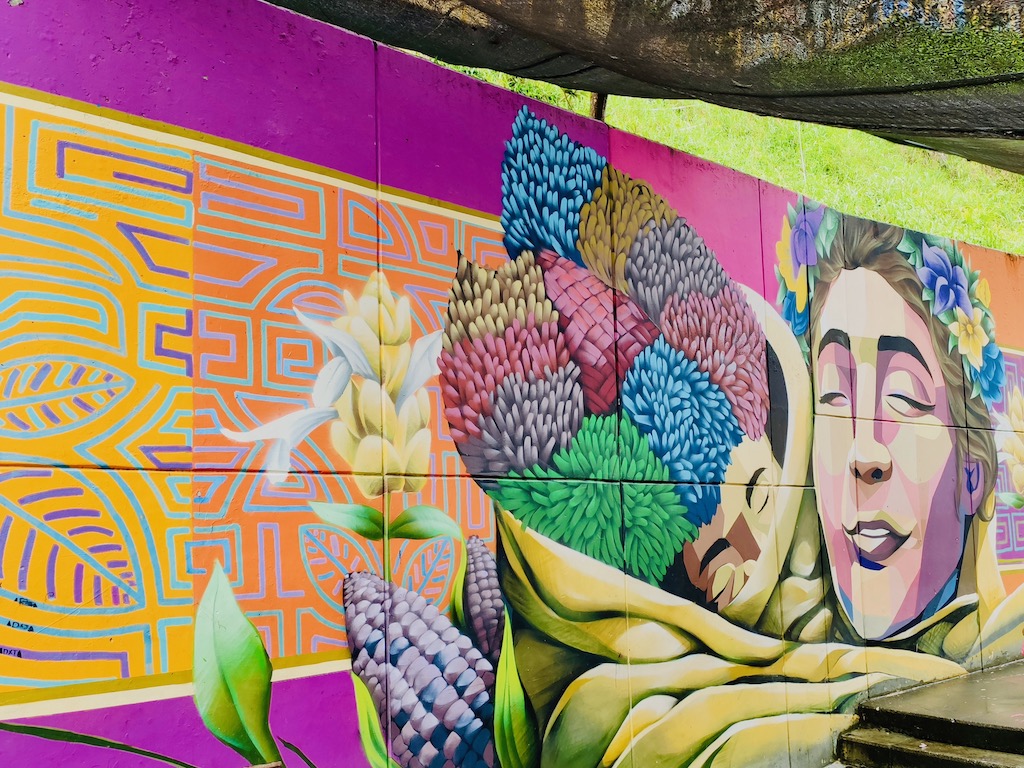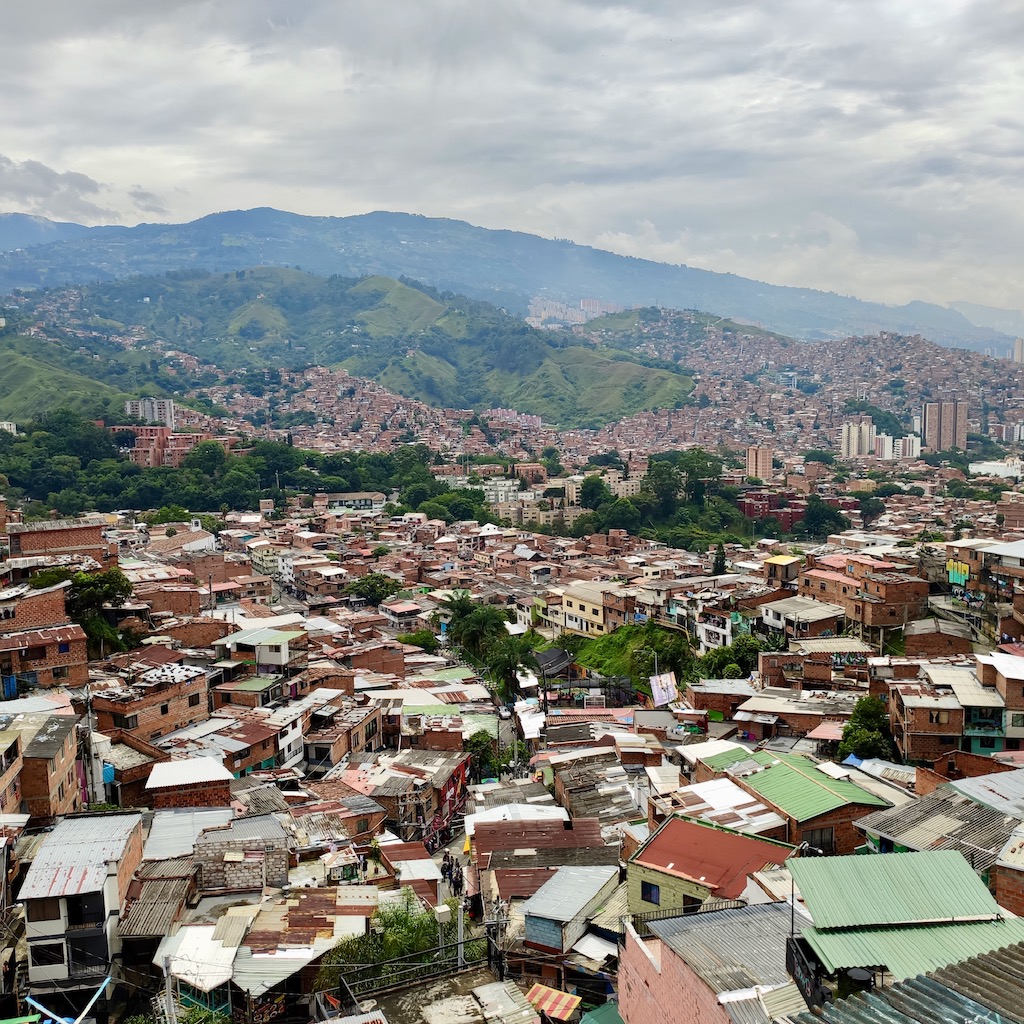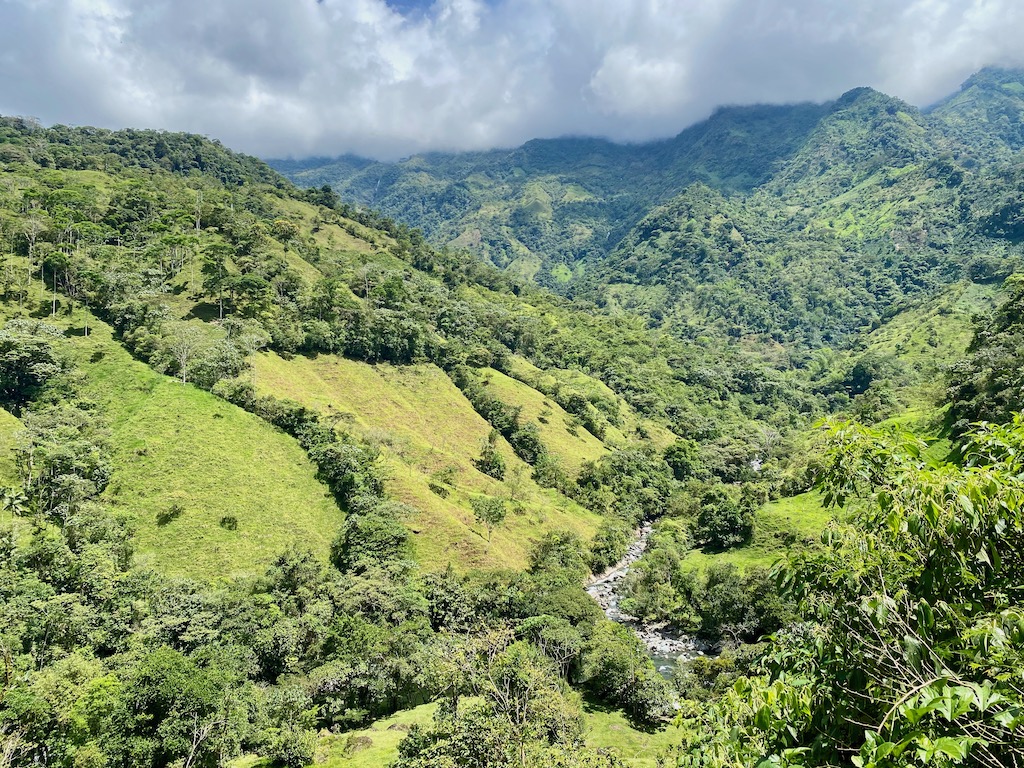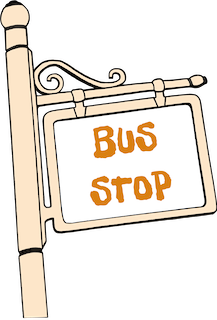

Medellín is a city that we really enjoyed. We felt comfortable there, as at home, more than in most of the places we stayed.
Which surprised us a bit, because there were warnings everywhere about the danger of the city and the country. A confirmation of what we already knew — not to believe everything that is written, and go see for yourself.
But don’t get me wrong. The country remains a country where precautions and recommendations must be taken, even if the big cities are open, welcoming and safe.
Medellín
Medellín is the capital of the Antioquia region and the second city in Colombia after Bogota. It is a city where people feel good. The weather is warm and beautiful throughout the year with temperatures hovering around 22°C.
For this reason the Paisas — the name given to the inhabitants of Antioquia — affectionately call it the “city of the eternal spring.”
It has become a modern city with its many hip restaurants and fashionable bars. The terraces are taken over at the end of the afternoon and the relaxed atmosphere reflects the warm temperament of the Colombians, who like to get together to share good times.
The old city, though, is different. The ambiance is not the same, there is more poverty. It is also not recommended to walk there at night and during the day, you also need to be vigilant and be wary of pickpockets.
The main places we discovered
Cisneros Square, now the Park of Lights
In order to revitalize and make the old town more attractive, the municipality of Medellín decided to rejuvenate Cisneros Square in 2005. This is how 300 concrete and metal posts came to be, which light up at night.
Hence, its new name.




On the other side are the Edificio Carré and the Edificio Vásquez, two red brick buildings dating from the early 20th Century, the period of the industrial boom.




At the time of their construction, these two warehouses were the tallest buildings in the city.
History of Cisneros Square
Cisneros was the name of the Cuban engineer who led the construction of the Antioquia railway. When he died in 1898, the town gave his name to this square, located opposite the station of Medellín.
It was there that Medellin’s main market was located. Local farmers and merchants unload fruit, vegetables and other merchandise delivered by truck or train. It was also one of the earliest views of the city that visitors see upon arriving by train.
Unfortunately, after the collapse of the Colombian railway in the 1960s and the relocation of the market further into the city, Cisneros Square became the lair of thieves and drug addicts. One more reason why the place was rehabilitated.
Main Square – La Alpujarra Administrative Center
This square houses the government offices of the Antioquia region, as well as Medellin’s Town Hall.




A grandiose sculpture, Homenaje a la Raza by Rodrigo Arenas Betancur, stands in the middle. According to the Medellin Art Museum, the monument symbolizes the culture of Antioquia, its agriculture, religion, and solidarity.
Many other interpretations exist, all relating to the birth of the region.
Square Botero or Park Berrío




Walking around this square feels like visiting an open-air museum. Twenty-three sculptures by Botero donated to the city in 2002 are exhibited here.
What I liked the most was the way those statues of a great artist were integrated into the place. This is where locals come during the day to socialize, to hang out with their friends, or simply sit on the little wall to have a look around. We have done just hat!
We bought an ice cream — there’s ice cream everywhere because they love it — and sat down on a small wall to enjoy it while looking at the life around us.
A nice rest time after the visit of the city.










National Palace Mall




The National Palace was built in 1933 by Agustín Goovaerts to house public offices. In 1988, it was declared a historical and artistic heritage and then transformed into a shopping center in 1993.
Here you can find everything at great prices in an incredible setting!
The neighborhoods of Medellín & Comuna 13
Medellín has 16 boroughs, the comunas, which are divided into neighborhoods (barrios) and institutional areas. Each barrios is rated on a 0-to-6 scale, 6 being the best. This provides information on the social level of the neighborhood and therefore the price of rents and charges (energy, water, and other taxes). Because in the most luxurious areas, electricity is more expensive!
So comunas are not just vulnerable neighborhoods in Colombia, as I thought. That said, one of them, Comuna 13, became a tourist attraction, infamous due to the violence it witnessed. But there are plenty of other things to say about it!
Before starting to discover it, it is good to know its history, in order to become fully aware of the progress made by its inhabitants, of the work and energy that were necessary for its evolution.
For the history of Comuna 13 : click here
Visit to Comuna 13


After this little return to the past, it is time to go and discover this place.
We booked a guided tour with a local agency and guides. Thus, the guides who lead the visits have always lived in Comuna 13 and are very invested in youth aid associations. They are the perfect interlocutors to present their neighborhood, paint a picture of what their life was like here when they were children, and talk about the evolution of the neighborhood until today.
However, it is quite possible to get to Comuna 13 by public transport and walk around the area. There’s no danger, no voyeurism. The locals have learned to integrate the tourists’ enthusiasm and the funding for their history and art, and are very welcoming.
Our visit


The topography of Medellín is better appreciated from the heights. Apart from the center of the city that follows the river and is flat, the other neighborhoods were built on the flanks of the surrounding hills. The roads are very narrow, so you can’t drive there; on the other hand, people tend to use motorcycles anyway.
The cableways and escalators have all their raison d’être!
Associations for young people
Artistic activities are offered to young people to divert them from gangs and arouse their curiosity in a better way. As we visited beautiful art galleries and attended street shows, each of us was enthused by the quality of the performances and the joy that could be seen on the faces of young artists. A great reward for them!
It takes perseverance and hours of rehearsal to reach such level of quality.
How Comuna 13 became famous
When a relative peace was established in the commune — no more gratuitous gang violence — the inhabitants decided to beautify their neighborhood. The first works appeared at the same time as the youth associations. The original goal was not to make the place attractive for tourists, but just a more pleasant place to live.
This is the beginning of street art, rap and breakdance in Comuna 13.
And we know the rest; the first visitors, enthused by the beauty and originality of the paintings, spoke about it. This led to the arrival of others curious, and from one thread to another, Comuna 13 became a must-see in Medellín.
The Antioquia Museum
A must do for me, a complete fan of the statues all in roundness of Botero.
The Antioquia Museum is an art museum located in Botero Square which houses a large collection of works by Fernando Botero and Pedro Nel Gómez, natives of Medellín.


So, after a walk amongst the beautiful statues in the park, if you want to see more Botero art and discover Pedro Nel Gómez, do not hesitate.
I guarantee you won’t be disappointed.
Fernando Botero – 19 April, 1932
This Colombian figurative artist and sculptor created his own style, the “Boterismo.” He creates characters in large exaggerated volumes, which represent political criticism and humor.
Dubbed “the most Colombian of Colombian artists,” Botero gained national notoriety when he won the first prize of the Salón de Artistas Colombianos in 1958. After moving to Paris in 1973, he began creating sculptures, gaining international recognition with exhibitions around the world in the 1990s.
Museum El Castillo




Before being a museum, this building inspired by the castles of the Loire and built in 1930 in the medieval Gothic style was the country house of Mr. José Tobón Uribe, doctor and founder of the pharmacy Pasteur, pioneer in Medellín.
Walking from room to room, I would call it a princess castle!


In 1942, it changed ownership.




Antioquian philanthropist Diego Echavarría Misas and his wife Benedikta Zur Nieden acquired the house. They decided to make it a cultural center open to all, introducing artworks of value from different currents, eras and places around the world.


These included works by European artists, precious furniture from the late 19th and early 20th centuries, Baccarat glassware, tableware and porcelain, as well as many works by Colombian masters in ceramics, painting and sculpture, among other disciplines.
Opening up the culture to everyone was an excellent idea. In addition to the exhibits, the house itself is equally amazing. It’s truly an enchanting place!
Park Arvi – Medellín
If you like nature watching, bike rides, or hikes, Arvi Park is for you.




It is also very easy to reach. A ski lift that leaves from the center of Medellín drops you off at the entrance to the park after about 30 minutes of flying over the forest.
On top of that, it offers a magnificent view of Medellín.


We had a nice walk on our own through the forest.
If you prefer, there are guides waiting at the entrance to accompany you.
Although they told us that it’s at our own risk to go alone, we found that there was not too much to worry about. There are no more risks than anywhere else, and the paths are very well-marked.
An open-air food market is located next to the cable car station, and a little further, there are also several restaurants that offer local specialties.
Everything is prepared for us to spend a beautiful day in the middle of nature!


A little further from Medellin
Hiking in the neighborhood of San Francisco, Antioquia


We chose a day trek from Medellín to discover the mountainous landscapes of Colombia. We hiked along the Santo Domingo River, the valley of waterfalls, to the Esmeralda waterfall.
For this trip, we booked with the agency, Aventura San Francisco.
If you want photos of this beautiful landscape, it’s this way.
Peñón de Guatapé – Guatapé


Another excursion to do around Medellín. If you like water sports, this is the right place to enjoy it. Because besides the town of Guatapé and the famous rock of Guatapé, you can fully enjoy the nautical base. Kayak, paddle, jet ski, cruise on the lake among others are offered here.
So feel free to spend the whole day.
For a bigger discovery of the rock of Guatapé, click here.
Pablo Escobar
What about Pablo Escobar?
Everyone knows his story and many have seen the latest series that came out about him.
I’m not going to dwell on him because it’s a taboo subject in Colombia. Colombians no longer want his name associated with them. They want tourists to know them for the generous and welcoming people they are, not for the sordid history of their drug dealers.
Drugs and drug trafficking remain a huge scourge here, and parts of the countryside are still managed by guerrillas and other arms groups. That’s a reality, and I think it’s important to know that.




But Colombia has a lot of great things to offer, so you might as well take advantage of those rather than focus on this darker part of the country.
Final word
Colombia was a real discovery for me. In addition to the magnificent landscapes, the kindness of the Colombians and the warm welcome we received were the highlights of our stay.
And it was not just in tourist spots. Also in our everyday life, whether in our sports club, on outings or in small shops. An idyllic stay!


It is also a large country with so varied climates. We spent a week in Barranquilla, a small village with white sand beaches on the country’s northern coast. Surfing and bathing in the Caribbean Sea.
In the south, complete change of scenery. These are the mountains, the high peaks of the Andes, with Bogota at the center, located at 2640 m above sea level.
Suffice it to say that any traveler visiting this country may return with completely different landscapes in mind. I found it after I met some people.
However, we all agreed on one fact: Colombians are perfect hosts.


